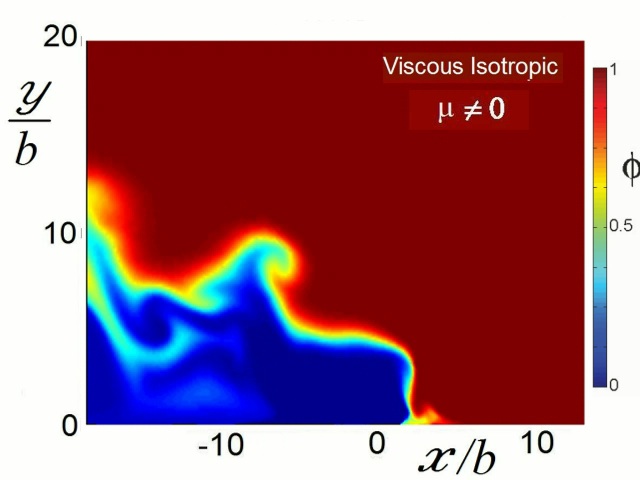This animation of a 2D LES numerical simulations
shows how the velocity profile at the source creates oscillations at
the cloud interface in viscous fluids. Using these simulations, we show
in the above paper that air entrainment at the head of powder snow cloud is small, but that it is significant in the tail.
Animation of 2D numerical simulations showing how the source velocity profile can swell the interface and produce oscillations if the fluid is viscous. Sequences all share the same rc = 0.64 and z=0. The color scale shows the local volume fraction f of ambient fluid. One second of real time in this movie corresponds to 39 b/U. Starting with the introduction of source fluid, an "inviscid RHB" having source velocity in Eq. (33) grows to a tail height H = p b. As soon as the source velocity distribution turns "isotropic" at the finite radius rc (i.e. conforming to Eq. 39), the region of source fluid expands outward. However, no oscillations are observed until viscosity is introduced, here through an LES with Re = r U b/m = 2300. Despite large-scale instantaneous interface oscillations, the head region below the time-averaged LES interface exhibits similar "source-induced swelling" than in the inviscid case.

Animation of 2D numerical simulations showing how the source velocity profile can swell the interface and produce oscillations if the fluid is viscous. Sequences all share the same rc = 0.64 and z=0. The color scale shows the local volume fraction f of ambient fluid. One second of real time in this movie corresponds to 39 b/U. Starting with the introduction of source fluid, an "inviscid RHB" having source velocity in Eq. (33) grows to a tail height H = p b. As soon as the source velocity distribution turns "isotropic" at the finite radius rc (i.e. conforming to Eq. 39), the region of source fluid expands outward. However, no oscillations are observed until viscosity is introduced, here through an LES with Re = r U b/m = 2300. Despite large-scale instantaneous interface oscillations, the head region below the time-averaged LES interface exhibits similar "source-induced swelling" than in the inviscid case.

